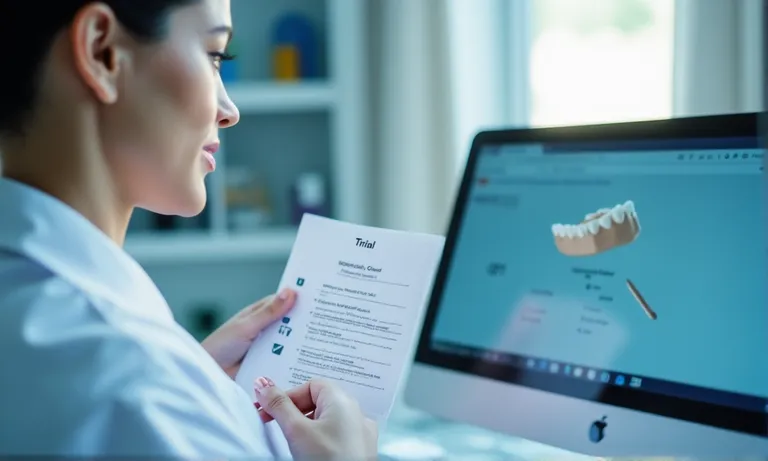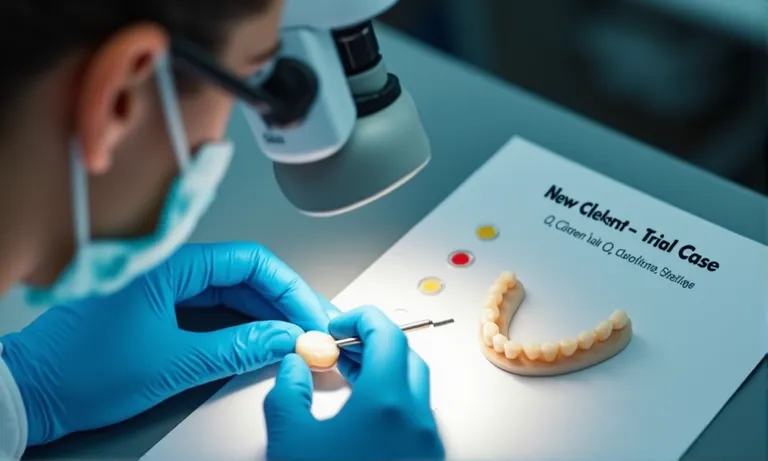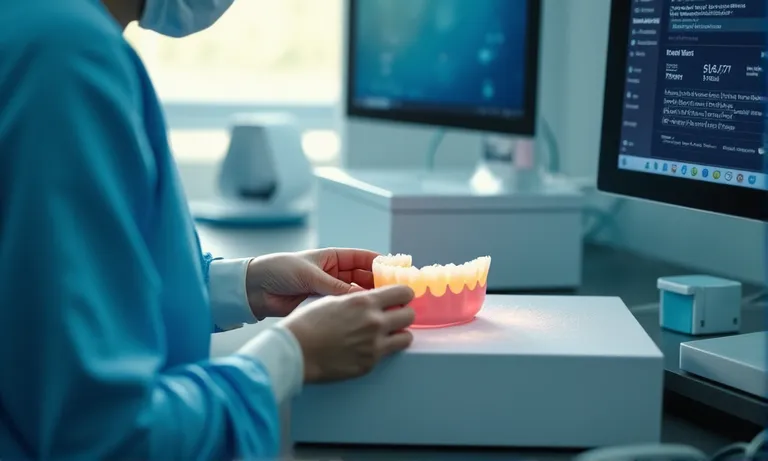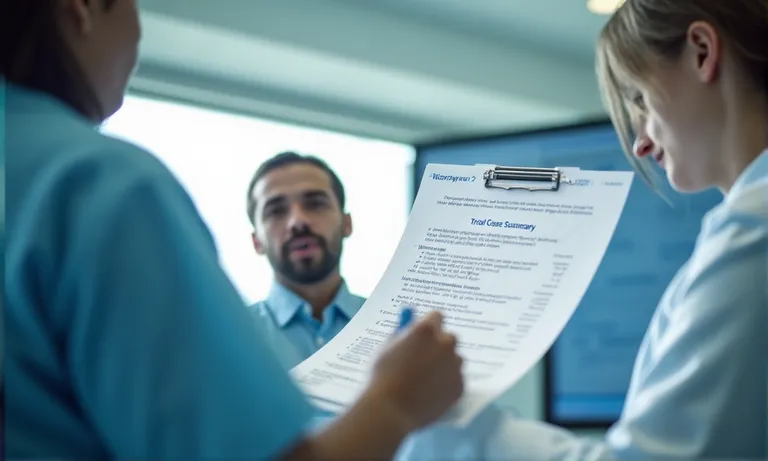Starting a new partnership with a dental lab often begins with uncertainty—Will the quality hold up? Will turnaround meet clinical needs?
Without a structured trial submission, even the best labs may misinterpret design preferences or miss logistical windows.
Raytops Dental Lab helps clients launch with confidence by standardizing trial workflows, QC benchmarks, and post-case feedback to turn the first order into lasting cooperation.
A standard dental lab trial includes:
- Submitting a simple case (e.g., single-unit crown) with clear STL and Rx files
- Following enhanced QC checks for fit, occlusion, and shade
- 5–7 day turnaround with tracked shipping
- Defined remake policy and feedback loop
- Post-trial review to evaluate fit, service, and next-step terms
This structure helps both clinic and lab align expectations from the first case.
What Key Steps Are Involved in Submitting a Trial Case to a New Lab?
Submitting a trial case to a new dental lab requires clear case selection, file preparation, and communication alignment. A structured start avoids delays and ensures both parties evaluate the partnership under optimal conditions.

Dental-Trial-Case-Submission-Steps
Choosing the Right Case Type for Evaluation
Not all cases are ideal for trial submission. Simpler restorations allow clearer benchmarking.
- Single-unit posterior crowns (zirconia or PFM) are common for first case
- Avoid complex bridges, full-arch, or implant cases for initial evaluation
- Select a case that reflects your daily workload, not rare exceptions
- Ensure sufficient occlusal clearance and margin exposure for assessment
Preparing STL Files and Clinical Documentation
A successful submission starts with clean, usable data.
- STL files must have visible margins, proper arch orientation, and no stitching errors
- Include bite scans, opposing dentition, and any supporting photos (shade, intraoral)
- Rx should specify material, margin type, shade, and design preferences
- Add notes for special features like connectors or pontic design
Submission Formats: Digital vs Traditional Workflows
Choosing the right format depends on your equipment and habits.
| Aspect | Digital Submission | Traditional Submission |
|---|---|---|
| Format | STL files + PDF Rx + photo uploads | Physical impressions + written Rx |
| Speed | Uploads instantly, no courier time | Requires shipping, adds transit days |
| Common Issues | File distortion, missing Rx, margin errors | Impression drag, tearing, unclear handwriting |
| Compatibility Notes | Ensure scanner software exports binary STL | Package must include return label and ID form |
Providing Clear Design Parameters and Case Instructions
Clarity prevents misinterpretation.
- Be explicit about material choice (e.g., full-zirconia vs layered)
- State margin type, finish line, and any prep detail that impacts fit
- Include photos of preparation if available, especially for esthetic zones
- Add comments on occlusion scheme, contact preference, or bridge connectors
A well-prepared trial case helps labs deliver quality faster and avoid rework from day one. For a smoother experience, download our trial submission checklist to align every detail before you send.
What Quality Standards Are Applied to First-Time Trial Cases?
Trial orders aren’t just samples—they’re treated as production-grade cases with additional checks. A well-run lab uses trial cases to demonstrate quality consistency, not to over-deliver on a one-time promise.

Dental-Trial-Case-QC-Standards
Internal QC Steps for New Customer Cases
Our trial QC process includes multiple checkpoints to ensure consistency and gather early feedback.
- Margin validation using digital overlay and microscope check
- Model articulation and occlusion test for physical or 3D-printed models
- Design accuracy check against Rx instructions
- Shade, surface, and texture match per submitted references
- Final inspection by senior technician or QA manager
Fit, Occlusion, and Aesthetic Evaluation Points
We apply practical benchmarks commonly used in routine case evaluations.
- Passive fit on model or digital articulation
- Occlusal contact mapped to 40–60 μm range
- Consistency of shape and emergence with neighboring teeth
- Shade match (within 1 Vita step tolerance if no photo provided)
Differences Between Trial and Standard Production Cases
| Aspect | Trial Case | Standard Case |
|---|---|---|
| Technician assignment | Senior technician or QA team | Assigned by case type or schedule |
| Extra QC steps | Yes – 2nd-tier manual inspection | Standard single-pass inspection |
| Feedback loop | Client-specific notes gathered post-fit | Reactive only if issues occur |
| Packaging note | Includes “Trial – Priority QC” label | Standard labeling |
Raytops Support: What Initial Quality Checks We Provide
Beyond regular QC, we add trial-specific support mechanisms.
- Dedicated case ID tracking with traceability across departments
- Photos of final work shared upon request
- Pre-shipment check-in for any unclear instructions
- Post-delivery follow-up for fit, esthetics, or feedback questions
✅ Trial cases go through enhanced quality checks – TRUE
Each trial case is routed through a stricter, double-inspected QA process to validate first impressions.
❌ Trial cases are only for show and don’t reflect real production – FALSE
Trial orders at Raytops reflect the same systems used in daily production—with added safeguards for transparency.
What Is the Typical Turnaround and Shipping Process for Trial Orders?
Starting a structured partnership with international clients means trial orders also require clear expectations around turnaround and shipping logistics. By defining these upfront, labs and clinics can coordinate smoothly across time zones and customs boundaries.
For example, a trusted lab outlines preferred shipping methods (e.g. DHL Express, UPS Saver), packaging protocols, and customs documentation—ensuring cases arrive intact and on schedule.

Dental-Trial-Case-Shipping-Logistics
Average Lead Time for Trial Orders
Turnaround time depends on the type of restoration and clarity of case information.
- Single-unit zirconia or PFM crowns: 4–6 working days in-lab
- Layered or esthetic cases: 7–9 working days
- Additional time may apply if:
- STL files are incomplete or margin clarity is poor
- Design clarification or Rx details require confirmation
- The case involves special components like implant analogs
How to Prepare for International Shipping & Customs
Proper packaging and documentation minimize delays.
- Use full clinic name and address (no abbreviations) to match courier systems
- If physical materials are included, mark contents as “Dental prosthesis – no commercial value” to streamline clearance
- Provide clinic tax ID or EORI number (EU/UK) if applicable
- Confirm shipping preference: DHL, FedEx, UPS or preferred partner
- Note any clinic closure dates to avoid missed deliveries
Coordinating Tracking and Delivery Confirmation
Labs and clients should stay aligned once the shipment leaves the facility.
- Tracking number is shared within 24 hours of dispatch
- Real-time status can be viewed via shared dashboard or email updates
- Client confirms case receipt and notes package condition
- Any transit-related issues are logged and reviewed in internal system
- Optional: courier photos or unboxing video to verify content integrity
A clear timeline and shipping process build trust in early cooperation. Keeping all delivery variables visible helps reduce guesswork, especially during trial periods.
What Happens If Adjustments or Remakes Are Needed During the Trial?
In the trial phase, occasional remakes or adjustments are natural. A transparent and timely resolution process ensures confidence in future cooperation—and reflects how a lab handles real-world complexities.

Dental-Trial-Remake-Communication
First-Order Remake and Adjustment Policy Explained
Raytops provides remake support for trial cases to build trust and ensure fit confidence.
- One-time free remake applies per trial case, subject to clear return documentation
- Minor adjustments (e.g. contact tightening) may be handled without full remake
- Remake lead time matches original turnaround (e.g. 5–6 working days)
- Shipping cost for remakes may be shared or covered depending on issue type
- Cases involving missing files or unclear Rx may be excluded from remake guarantee
Typical Scenarios Covered by Free Remakes
We categorize remake eligibility based on root causes and available data.
- Internal fit issues clearly visible on model
- Contact points too tight or open beyond standard tolerances
- Shade mismatch exceeding 1–2 Vita steps (if shade photo provided)
- Material or design not matching the written Rx
- Production damage before delivery
Communication and Feedback Loop After Initial Delivery
Clear, time-bound communication ensures any issues are resolved smoothly.
- Client sends remake request within 3 business days after delivery
- Include photos of restoration on model or intraoral if available
- Lab reviews case and confirms remake eligibility
- If remake is approved, client receives revised delivery estimate
- Final outcome is recorded in client feedback log for future refinement
Trial cases aren’t about perfection—but how both sides handle imperfection. To ensure clarity from the start, request our trial remake policy and learn how we help clients resolve early-stage issues with care.
How Can You Evaluate a Trial Order and Move Toward Ongoing Cooperation?
Starting a successful partnership requires more than a great trial—it also means building long‑term collaboration through structured evaluation, internal alignment, and joint workflow planning.

Dental-Trial-Evaluation-Cooperation-Flow
Evaluation Checklist: Fit, Turnaround, Communication
Successful labs perform well across three dimensions—not just esthetics.
- Fit and occlusion: Passive seating, no adjustments or minimal chairside polish
- Turnaround adherence: Met promised schedule and delivery window
- Communication flow: Response speed, file handling, and clarity of updates
Collecting Feedback from the Clinical Team
Involving the treating dentist ensures real-case evaluation beyond lab reports.
- Get feedback on fit, contact, shade from the chairside experience
- Note whether seating required adjustments or remakes
- Include technician input if applicable (e.g., design clarity, Rx usability)
- Consolidate into internal trial review document
Discussing Next-Step Terms: Volume, Pricing, Documentation
From one trial case to consistent supply, key terms must be addressed.
- Discuss expected monthly volume, restoration types, and peak seasons
- Review pricing tiers, remake policies, and rush order availability
- Align Rx formats, STL submission protocol, and shade reference standards
- Define case cutoff times and shared holiday schedules
Raytops Collaboration Onboarding Options
We offer structured onboarding to turn trial success into sustained performance.
- Assigned account coordinator with follow-up frequency
- SLA template for optional volume/quality targets
- Technical onboarding session for digital teams
- Ongoing case review to track remake ratio and delivery metrics
✅ Trial satisfaction must lead into structured onboarding – TRUE
Even when a trial meets expectations, a clear process is needed to lock in communication flow and production norms.
❌ A successful trial alone guarantees long-term consistency – FALSE
Without structured handoff and cooperation terms, even good trials may falter under volume pressure or unclear expectations.
Conclusion
A trial order is more than a test of skill—it’s the foundation for future collaboration. At Raytops Dental Lab, we help clinics evaluate us with clarity and confidence, offering structured onboarding, defined QC checkpoints, and transparent resolution policies that turn first cases into long-term trust.
- Successful onboarding starts with a step-by-step trial submission process, including case type selection, file prep, and instruction clarity.
- Labs should apply enhanced quality control for trial cases, with extra checkpoints and technician oversight to validate core capabilities.
- Clients must understand turnaround and shipping processes specific to trial cases, especially for international delivery and tracking.
- A defined remake and adjustment workflow during trial ensures fast, fair responses when early corrections are needed.
- Long-term collaboration grows from structured trial evaluation and onboarding planning, including SLA terms, team feedback, and file protocol alignment.
To streamline your evaluation process, connect with Raytops Dental Lab and request our trial onboarding checklist and QC alignment guide.


